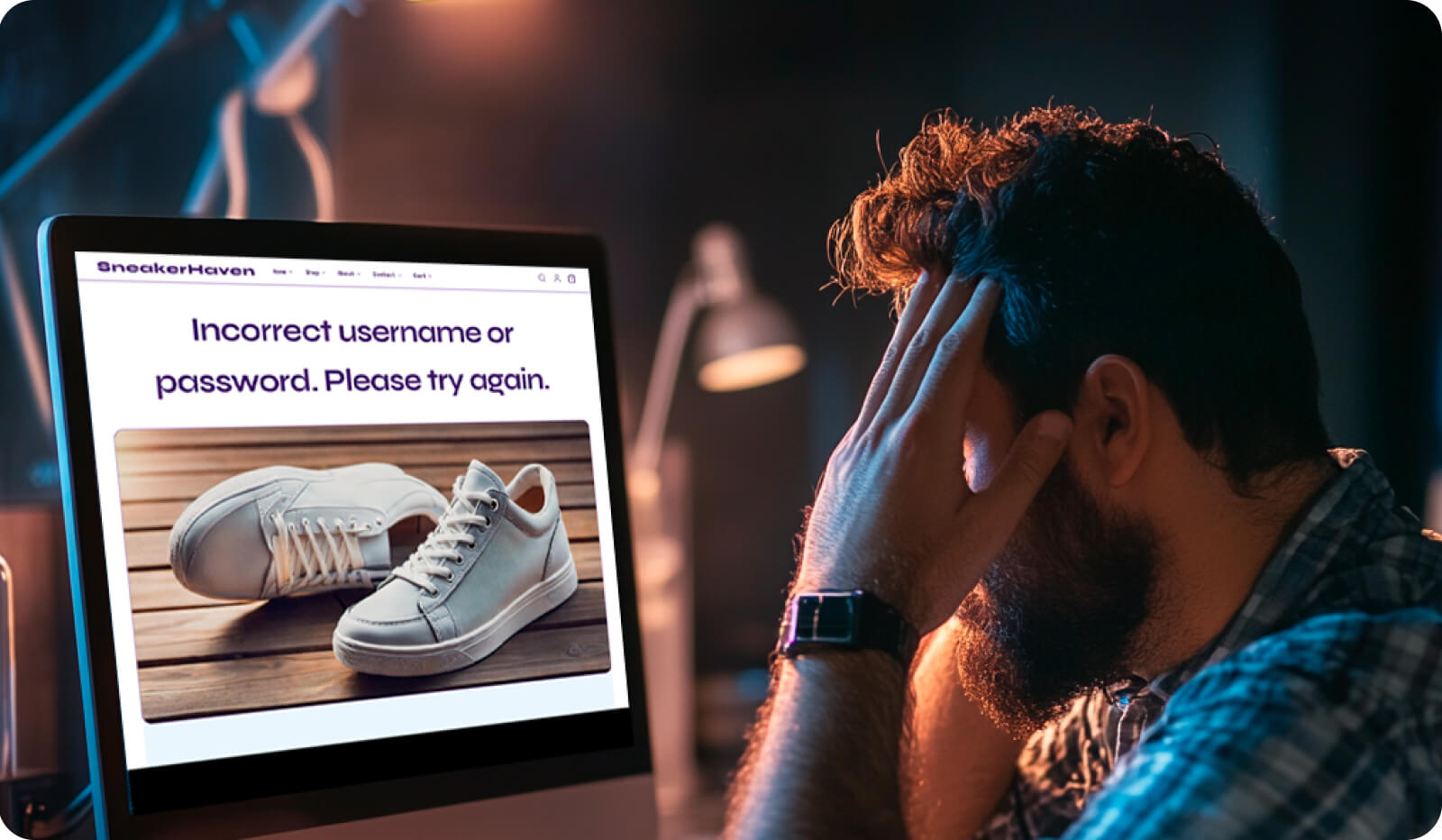Table of Contents
In an ideal world, getting more traffic to your site is great news. Unfortunately, reality often proves different. Over the years, we've noticed cases where even major ecommerce websites or popular online platforms face website crashes during busy periods. Most people think these crashes occur simply because too many customers try accessing the site at the same moment.

However, a webpage crash isn't always just about overwhelming traffic. Actually, there are several other common reasons behind it. Understanding these clearly can help you quickly solve the problem and even avoid it in the future.
In this article, we'll explore the key reasons behind most crashes. We’ll also provide insights on how to solve these issues and give practical advice on how to prevent ecommerce website crashes.
What Causes a Website to Crash?
There are various reasons why websites crash due to high traffic—it could be sudden spikes in visitor numbers or technical issues at your hosting provider. Knowing exactly why websites crash makes it much easier to handle these problems quickly.
So, why do websites crash exactly? Based on feedback from businesses and web developers, we've identified 6 primary reasons your website can go down. Let’s examine each of these closely in this article.
1. Unexpected Traffic vs. Lack of Resources

Can too much traffic crash a website? Every site owner dreams about traffic surges, but when website visitors suddenly increase too fast, you might unexpectedly discover how to crash a website.
You never really know exactly how much traffic your site can handle until it reaches its limit. If your site doesn't have enough resources, like server memory (RAM) or bandwidth, it can quickly become overloaded. This often leaves you wondering, "Why does my website keep crashing?"
Massive Traffic and Site Bottlenecks
Many things affect how your site normally runs. For example, reports can tell you the average number of visitors, but they can't predict when you'll experience massive traffic.
Here's a simple example: the "Meghan Markle Effect." Meghan Markle is known worldwide, and when she wears something new, many customers rush to buy the exact same item online. Suddenly, your online store gets flooded with visitors who make many requests at once. This puts your site under heavy pressure.
Some requests from customers are simple. Your site normally handles these smoothly. But when a visitor wants to purchase something, the process becomes more complicated. The customer goes through multiple steps, including registration, selecting items, and providing payment and delivery information. All this data needs to be carefully saved in your database.
Your site also checks inventory, verifies users' logins, and manages payment details. All these steps together create bottlenecks, slowing everything down. When too many customers perform these actions at once, the site becomes overloaded, causing your server resources to run low.
Imagine your site working fine with just a few visitors. Now picture all your customers deciding to buy the same product simultaneously. The checkout area, like the register in a physical store, can only handle so many people at a time. People start forming long lines, waiting their turn.

Eventually, these lines get so long that some customers give up and leave. They feel frustrated and might never return. Similarly, your online system may become unable to handle the incoming requests quickly enough. It struggles to update stock and manage payment information, slowing down your entire site.

When your server can't handle this heavy load of data and requests, it will start showing error messages, eventually causing your website to crash.
Database and Its Overload

Actually, it can happen even when your site seems to have enough resources. The database is where your site stores all the important data. Every time someone loads a page the site pulls information from the database.
But when many customers constantly send requests, the database can quickly get overloaded. This overload slows down your site, causing a website to fall, even if your server has enough capacity.
Here are a few notable examples of major websites that suffered crashes because of this:
- Amazon experienced a major fall during its Prime Day sale in 2018.
- Spotify crashed in 2022 due to massive fan activity over Taylor Swift's new album.
- The IRS site crashed twice, in 2018 and 2022, as many customers submitted tax forms at the last moment.
What to do if a website keeps crashing? The best solution is to distribute traffic spikes evenly. You can use global servers, cloud solutions, or crash detection software.
To do this effectively, you must study the patterns of user requests. These patterns vary, making it difficult for servers and your entire website infrastructure. By understanding this clearly, you'll see the limits of your weakest points. Set these limits carefully and prepare extra resources to prevent your website from falling.
2. Unstable Network and Provider Pains

Having stable internet is crucial, but it's not always enough. Your provider might struggle to handle unexpected high traffic or sudden equipment problems. Even if other sites run smoothly with many simultaneous requests, your site might constantly go down because of your provider's issues.
Hosting Provider Errors and Old Equipment

If you're not hosting your own site or haven't changed your site's code recently, the problem is probably with your hosting provider. Errors or instability on the provider's servers can cause your webpages to crash regularly.
When this happens, your customers get frustrated. They refresh the page multiple times, but instead of getting the information they want, they just see broken or unresponsive parts of your site.
Your hosting provider might also become a victim of DDoS attacks, affecting thousands of websites at once. Maintenance activities after such attacks can further slow down your site.
Old equipment provided by your hosting provider is another common problem. If the provider uses outdated technology, your website will eventually experience a serious situation. Older software requires more server capacity and is less optimized overall.
Unfortunately, you can’t directly fix issues like bad weather, overheating equipment, or configuration errors—these are out of your control. Only the provider decides the strength and reliability of their servers and infrastructure.
Modern network systems have a complex structure. If even one part of the system fails, your entire site may go down. This will leave you facing a significant "website crashed meaning," where your site is offline and unreachable for your customers.
- Dyn DNS, a large hosting provider, suffered a DDoS attack, causing over a thousand websites to crash simultaneously.
- Damage to a fiber cable during a Black Friday event caused more than 2,000 Danish websites to go offline.
There's only one way to truly prevent a website crash caused by poor hosting providers: carefully check your current provider and consider better alternatives. Before switching, investigate each new hosting provider properly. Check hardware quality, rankings, and reviews from other people to make sure it’s a reliable choice.
3. Technical Errors

A fall can easily happen if you accidentally break your code, incorrectly set plugins, or install updates that don't match your site's needs. As a result, you and your visitors might see some pages showing strange errors or not loading properly. These issues are known as technical errors, often caused by the system itself or human mistakes. Usually, site owners can solve these issues on their own.
Code Bugs
One of the most common reasons is mistakes in the code, typically caused by human errors. Web developers create code that makes your site user-friendly and easy to navigate.
But if the code gets broken or damaged, your users can't properly view the page or perform important actions like buying something, updating information, or browsing further.
For your site to run smoothly, every line of code must be correct. Unfortunately, finding and correcting these mistakes takes time. The worst scenario is having multiple broken lines of code, as this can quickly lead to a serious situation.
Plugin Issues
Plugins are small software extensions that help your site offer useful features to people. For example, they let visitors pick themes, apply filters, fill out forms, use calendars, and more.
However, plugins also contain code written by developers, so if you pick unreliable providers, you risk adding faulty extensions to your site. Another tricky aspect is that plugins require frequent updates to keep working properly.
If you install outdated or poorly coded plugins, your site can quickly experience a crash.
Updates
If your site runs on a CMS like WordPress or Shopify, regular updates are important. Skipping these updates might cause security issues, making your site vulnerable to attacks. Even a small malware attack could lead to a serious website crash.
On the other hand, partial or incorrect updates can also harm your entire site. Eventually, your visitors will struggle to perform even simple requests, and the problems will only worsen over time.
- Facebook’s updates in 2020 broke the "login with Facebook" feature, making it impossible for people to access Spotify and Tinder.
- Google experienced a large outage in 2022 caused by updating several services, including Maps, Search, Drive, and YouTube.
- Meta faced a 7-hour outage because of human error in the code.
How to fix a crashed website? Always test every new element or update carefully before applying it to your site. Choose reputable and licensed software providers to get quick support if any issues occur, and don't forget to regularly install important updates.
4. Security Problems and Malicious Attacks

A crashing website often happens because of weak site security. Hackers constantly create new malware to steal money or valuable data. That's why it's critical to regularly apply security updates.
Certificate Problems and Malware Attacks
An SSL certificate helps protect the users of your site by encrypting their data. This prevents hackers and malicious attacks from accessing sensitive information.
However, if your SSL certificate expires, your site becomes vulnerable. Hackers can easily exploit this weakness.
Hackers also use harmful software, such as malware or distributed denial of service (DDoS) attacks, to damage your website. These malicious attacks try to overload your server with fake, overwhelming traffic spikes, making your website run out of resources and eventually fall.
Site owners usually notice the following signs of malware attacks:
- Unexplained long traffic surges.
- Sudden traffic spikes without clear reasons.
- Slow loading site pages.
Malware is especially dangerous because it doesn't just aim to crash your website. It can also steal important information, money, or damage your reputation.
Bots and Harmful Third-Party Software
Another common way hackers cause a website to crash is by sending harmful bots. These bots bombard your website by sending many useless requests, like fake registrations or support questions.
These repetitive requests overload your database, causing your web page crashed due to the fake traffic spikes.
Additionally, if you add extra features to your site using an unauthorized plugin, you might accidentally introduce harmful software. The Internet is filled with developers who provide software solutions. But not all plugins are safe and trustworthy.
Sometimes, choosing a free plugin from an unknown developer can be riskier—and ultimately costlier—than buying one from a reliable provider.
- The Nike app faced a massive bot attack during the Air Jordan launch in 2022.
- GitHub's site completely crashed after a DDoS attack in 2018.
- In 2000, a hacker known as "Mafia Boy" launched malicious attacks, bringing down major websites like CNN, Dell, eBay, and Yahoo!
To effectively prevent a website crash caused by distributed denial (DDoS) attacks, choose reliable hosting that offers strong protection. Consider installing software that scans your website regularly, detects vulnerabilities, and stops potential threats before they become real problems.
5. Crashes Caused by Other Side-Platforms

Most sites depend not only on their own hosting providers but also on services known as CDNs (content delivery networks). These networks have a direct impact on many sites at once. So, if a major CDN provider experiences issues, your website will also go down.
Big cloud companies like Google or Cloudflare manage many important services online. If they have problems, thousands of websites can suddenly go offline because:
- You can’t directly control or influence how these services work.
- The market has only a few huge providers.
Major sites and apps heavily rely on these primary CDN providers, so their outages can disrupt your business and even lead to losing big sales.
According to Statista.com, major CDN providers like Cloudflare, AWS, and Akamai control around 89% of the global CDN market. Google, Amazon, and Microsoft manage approximately 66% of the global cloud market. Even though these companies are generally reliable, they're not immune to failures.
- A major outage of the AWS provider in 2022.
- Google Cloud faced service disruptions in 2023.
- The massive crash of Fastly, a large CDN provider, in 2021.
How to avoid website crash? Unfortunately, you can’t prevent or predict outages caused by big CDN providers. The best you can do is choose the most reliable services and hope for the best.
Even these huge cloud companies constantly optimize their data centers and operations to minimize downtime. As Amazon CTO Werner Vogel famously said, every data center can fail, so they constantly work to ensure the highest reliability.
6. Domains that Expired

Having an active domain is crucial for your site’s normal operation.
If you forget to renew your domain name, you can accidentally crash a website. Without an active domain, website visitors simply can't access your site.
But why does a website crash when this happens? The biggest risk is that your domain becomes free, allowing someone else to buy your URL—potentially leading to a disaster for your business.
- In the late 1990s and early 2000s, Microsoft forgot to renew their domains for passport.com and hotmail.co.uk.
- The well-known site Foursquare.com temporarily lost its domain, even though they had just received $10 million in funding.
- The Dallas Cowboys football team once forgot to renew their domain after firing their head coach. The two events weren't related—the administration simply forgot the renewal.
The simplest way to avoid this issue is to set your domain to auto-renew. You can also enable automatic reminders so that you never forget your renewal date, ensuring your website never crashes due to expired domains.
More Situations When Your Website is Most Likely to Crash

While you can't always predict sudden traffic spikes, there are certain events when site owners should be extra careful.
Running an e-commerce site has big benefits, especially during major sales, special promotions, or marketing campaigns. These events boost sales and help businesses clear out inventory.
Naturally, this means most people visit your site at the same time, creating a sudden traffic surge. Without proper preparation for this high traffic, your website might face difficulties and eventually drop.
Successful Promotions and Major Sales Events
So, why do websites crash when busy? Marketing campaigns that online stores frequently run attract many new visitors to their sites. These campaigns often occur during the holiday season or special events, like a store's anniversary.
Depending on how successful your campaign is, you might face unexpectedly high traffic.
For example, ecommerce platforms regularly host seasonal events, like Black Friday or Singles' Day, offering huge discounts. You can expect a massive traffic surge on these days. Observations show that traffic can jump up to 30 times higher during these sales. Such sudden increases mean unexpected problems become very likely, although predicting the exact time and day it almost impossible.
Limited Edition Products and Big Traffic
Sometimes, releasing limited or exclusive items can attract even more attention than regular major sales. These events quickly draw in many customers, leading to a rapid increase in visitors. In fact, this can cause your platform to slow down or go down even before the official sale starts.
What Happens to Users When Your Website Crashes?

But what exactly does "webpage crashed" mean? How does it look like? Normally, your server serves people by responding to their requests, like loading a new page, placing orders, or other common actions.
Earlier, we showed how multiple site visitors rushing to buy a product can overload your site. The result is the "webpage crashed" problem—visitors see various error messages like "503 unavailable" or "404 doesn’t exist."
When this happens, visitors can't easily access your site, they try to reload the page or open multiple tabs, causing a website failure due to the heavy load of simultaneous requests.
So, the key question is: "How do I prevent my website from crashing during big sales?". There are ways.
How to Prevent Website Crashes During High Traffic

You can easily prevent these situations due to high traffic by using smart solutions. If you don’t want to seek professional help, you can follow the recommendations of experienced website owners to prevent your resources from slowing down.
Constant Monitoring and Optimization
Switching to cloud hosting solutions helps handle website traffic spikes better. But how to fix a website crash or avoid it? Choose a server with stronger capabilities to handle sudden customer surges.
Although cloud services aren't perfect, they're typically more reliable than traditional local providers. Here’s how cloud hosting helps:
- reduces data load and lowers hosting costs;
- improves malware protection;
- increases website speed by distributing loads through a CDN.
But why does my webpage keep crashing? Whenever you update your site, install new plugins, or modify your code, test everything carefully. Watch how your website behaves when many site visitors arrive simultaneously.
If you see unexpected traffic spikes, act immediately to minimize the damage. Knowing exactly what each piece of your website’s code does can also help you quickly manage potential crashes. Consider leaving short notes in the code — they won’t affect website performance but will make solving problems easier.
Another important solution to the question "how to prevent a website crash from traffic" involves closing HTML tags properly. If tags are missing or incorrect, your website may not render pages correctly in various browsers. This will definitely slow down your site.
Load Testing and Extra Software for Traffic Spikes
Load or stress testing is one of the best ways to prepare your website for unexpected traffic spikes. Regular testing makes sure your website remains stable and responsive under heavy traffic conditions.
You can easily perform these tests using Perforator. Perforator is perfect for anyone. No matter if you’re new to performance, load testing, or an advanced user. It offers simple performance tests that require no coding skills, as well as advanced options for more complex scenarios. Perforator simulates real user activity using cloud browsers so that the tests show you the real situation, not a synthetic one.
If you want to make sure your website stays stable under pressure, Perforator is ready to help!
You might also wonder how long does it take to fix a crashed website? Usually, the quicker you notice the issue, the faster you can solve it. You can integrate specialized software that constantly monitors your site for unnatural website traffic or malicious attacks. Such software alerts you to act before serious damage is done.
Expert Guide: What to Do When Your Website Crashes

You can quickly fix your site when it’s down if you follow these simple steps. If you see a sudden rise in traffic, follow this checklist carefully:
- Check if the Site Is Down for Everyone. Act like a regular user and try to reach your website using different devices and browsers. If it’s down everywhere, proceed to the next step.
- Identify the Reason. Contact your hosting provider to check if they have technical issues. Call their support and stay online until you confirm the problem.
- Check for Security Issues. Quickly examine your website for potential vulnerabilities that might allow malware attacks. If you find any weak spots, remain calm and move to the next stage.
- Notify Your Visitors. Let your users know you're aware of the issue and working to solve it through other communication channels like social media or email.
- Prepare for the Worst Scenario. Always have a clear website crash back up plan ready in case the situation escalates. It’s better to do that beforehand to know exactly what steps you’ll take if the problem becomes serious.
- Fix the Issue. Finally, decide how you'll fix and restore your site with minimal cost and downtime.
Conclusion
Website crashes are serious and can negatively affect your business. They can simply make you lose visitors which costs you sales. You must be prepared to handle unexpected issues and keep your website running smoothly. We hope your website stays online and serves your customers well, even during the busiest times!
FAQ
When should I test my website for vulnerabilities?
The frequency of testing your websites for security weaknesses depends on how quickly new threats appear. Each year, around 8,000 new vulnerabilities are discovered, which means there are always risks. The more often you perform these and stress, web load tests, the safer your website will be.
What is a website crash?
This happens when your website stops working normally. It becomes slow, creates bottlenecks during checkouts or ordering, and may even become completely unavailable to your customers.
What is the fastest way to fix a crashed website?
The quickest way to fix it is to have a backup of your site stored safely on a different server. It’s also helpful to host your website on reliable cloud hosting servers with high limits, which can handle massive traffic.


